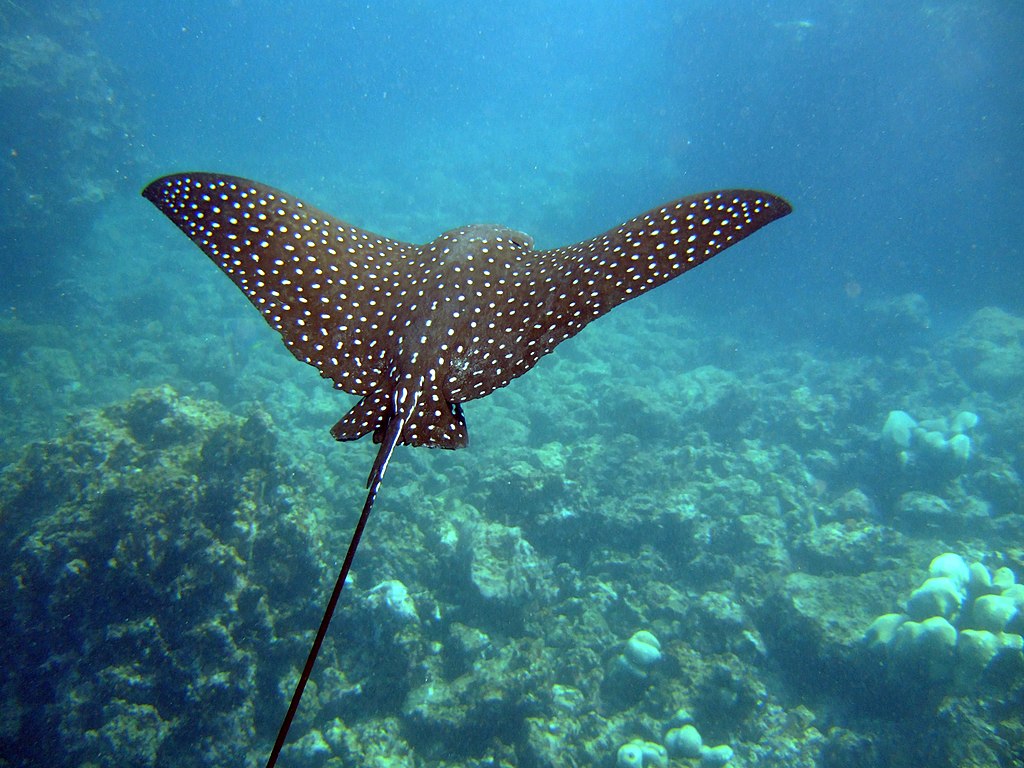This ray can be identified by its dark dorsal surface covered in white spots or rings. Near the base of the ray's relatively long tail, just behind the pelvic fins, are several venomous, barbed stingers. Spotted eagle rays commonly feed on small fish and crustaceans, and will sometimes dig with their snouts to look for food buried in the sand of the sea bed. These rays are commonly observed leaping out of the water, and on at least two occasions have been reported as having jumped into boats, in one incident resulting in the death of a woman in the Florida Keys. The spotted eagle ray is hunted by a wide variety of sharks. The rays are considered near threatened on the IUCN Red List. They are fished mainly in Southeast Asia and Africa, the most common market being in commercial trade and aquariums. They are protected in the Great Barrier Reef.
Taxonomy
The spotted eagle ray has many different common names, including white-spotted eagle ray, bonnet skate, bonnet ray, duckbill ray and spotted duck-billed ray.[6][7][8]
Description and behavior
Close up of the head
Mature spotted eagle rays can be up to 5 meters (16 ft) in length; the largest have a wingspan of up to 3 meters (10 ft) and a mass of 230 kilograms (507 lb).[11][12]
 Reproduction
Reproduction
One male, or sometimes several, will pursue a female. When one of the males approaches the female, he uses his upper jaw to grab her dorsum. The male will then roll the female over by grabbing one of her pectoral fins, which are located on either side of her body. Once he is on her ventral side, the male puts a clasper into the female, connecting them venter to venter, with both undersides together. The mating process lasts for 30–90 seconds.[4]
The spotted eagle ray develops ovoviviparously; the eggs are retained in the female and hatch internally, feeding off a yolk sac until live birth.[4] After a gestation period of one year the mother ray will give birth to a maximum of four pups.[2] When the pups are first born, their discs measure from 170–350 millimeters (6.7–13.8 in) across.[4] The rays mature in 4 to 6 years.[2]
Feeding and diet
Spotted eagle ray preys mainly upon bivalves, crabs, whelks, benthic infauna they also feed on mollusks, crustaceans, particularly malacostracans.[13][14] and also upon hermit crabs,[15] shrimp, octopi, and some small fish.[16]
The spotted eagle ray's specialized chevron-shaped tooth structure helps it to crush the mollusks' hard shells.[11][12] The jaws of these rays have developed calcified struts to help them break through the shells of mollusks, by supporting the jaws and preventing dents from hard prey.[1] These rays have the unique behavior of digging with their snouts in the sand of the ocean. [17] While doing this, a cloud of sand surrounds the ray and sand spews from its gills. One study has shown that there are no differences in the feeding habits of males and females or in rays from different regions of Australia and Taiwan.[14]
Behavior
Two spotted eagle rays swimming at the Okinawa Churaumi Aquarium
Human interaction
The dorsal spots make the spotted eagle ray an aquarium attraction, although because of its large size it is likely kept only at public aquariums.[6] There are no target fisheries for the spotted eagle ray, but it is often eaten after being caught unintentionally as bycatch.[6] There have been several reported incidents of spotted eagle rays leaping out of the water onto boats and landing on people.[19][20] Nevertheless, spotted eagle rays do not pose a significant threat to humans, as they are shy and generally avoid human contact.[4] Interactions with an individual snorkeler in the Caribbean has been reported especially in Jamaica involving one, two and even three spotted eagle rays. The rays may exhibit a behavior similar to human curiosity which allows the snorkeler to observe the eagle ray who may slow down so as to share more time with the much slower human observer if the human observer appears to be unthreatening or interesting to the spotted eagle ray.
Predators and parasites
The silvertip shark is a predator of the spotted eagle ray.
As other rays, spotted eagle rays are host to a variety of parasites. Internal parasites include the gnathostomatid nematode Echinocephalus sinensis in the spiral intestine.[24] External parasites include the monocotylid monogeneans Decacotyle octona,[25] Decacotyle elpora[25] and Thaumatocotyle pseudodasybatis[25][26] on the gills.
Distribution and habitat
An eagle ray searching the bottom for food
They are found in shallow coastal water by coral reefs and bays, in depths down to 80 meters (262 ft).[11] Spotted eagle rays are found in warm and temperate waters worldwide. In the western Atlantic Ocean it is found off the eastern coast of United States of America, the Gulf Stream, the Caribbean, and down past the southern part of Brazil. In the Indian Ocean, it is found from the Red Sea down to South Africa and eastward to the Andaman Sea. In the western Pacific Ocean, it can be found from the Red Sea to South Africa and also in northern Japan and Australia.[4] In the Eastern-Pacific Ocean, it is found in the Gulf of California down through Puerto Pizarro, an area that includes the Galapagos Islands. Spotted eagle rays are most commonly seen in bays and reefs. They spend much of their time swimming freely in open waters, generally in schools close to the surface, and can travel long distances in a day.[4]
Conservation
The spotted eagle ray is included in the IUCN's Red List as "near threatened". The rays are caught mainly in Southeast Asia and Africa. They are also common in commercial marine life trade and are displayed in aquariums. Among the many efforts to help protect this species, South Africa's decision to deploy fewer protective shark nets has reduced the number of deaths caused by entanglement. South Africa has also placed restrictions on the number of rays that can be bought per person per day. In the state of Florida in the United States, the fishing, landing, purchasing and trading of spotted eagle ray is outlawed. The spotted eagle ray is also protected in the Great Barrier Reef on the eastern coast of Australia.[3]In popular culture
Mr. Ray, a spotted eagle ray, appeared in the 2003 Disney/Pixar film Finding Nemo as a teacher to other young fishes, including Nemo. He also appears in the 2016 sequel Finding Dory, trying to find a substitute teacher so he can go on his annual migration, a job eventually filled by Hank, the "Septopus". Mr. Ray is voiced by Bob Peterson.






No comments:
Post a Comment
Note: Only a member of this blog may post a comment.